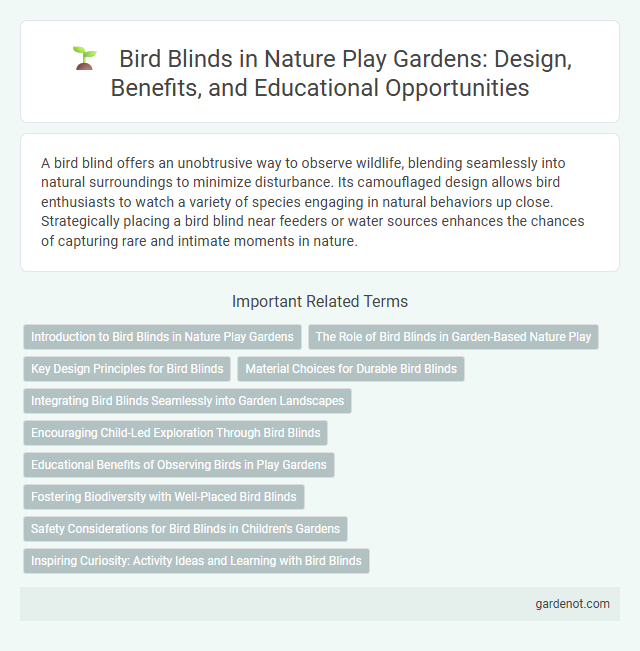A bird blind offers an unobtrusive way to observe wildlife, blending seamlessly into natural surroundings to minimize disturbance. Its camouflaged design allows bird enthusiasts to watch a variety of species engaging in natural behaviors up close. Strategically placing a bird blind near feeders or water sources enhances the chances of capturing rare and intimate moments in nature.
Introduction to Bird Blinds in Nature Play Gardens
Bird blinds in nature play gardens offer children immersive wildlife observation opportunities while minimizing human impact on bird habitats. These strategically designed structures blend into natural surroundings, allowing kids to witness bird behaviors up close and develop environmental awareness. Incorporating bird blinds enhances outdoor learning by fostering curiosity, promoting conservation values, and encouraging hands-on interaction with local ecosystems.
The Role of Bird Blinds in Garden-Based Nature Play
Bird blinds enhance garden-based nature play by providing a concealed observation point that encourages close wildlife encounters without disturbing bird behavior. These structures foster children's engagement with local biodiversity, promoting environmental awareness and sensory learning. Integrating bird blinds into natural play spaces supports experiential education and strengthens connections to urban and suburban ecosystems.
Key Design Principles for Bird Blinds
Bird blinds should be strategically positioned near natural bird habitats to ensure minimal disturbance while providing optimal viewing angles. Constructing with camouflage materials that blend seamlessly into the environment enhances concealment and promotes authentic wildlife behavior. Adequate ventilation, noise reduction features, and flexible viewing ports improve comfort for observers while maintaining the birds' natural activity patterns.
Material Choices for Durable Bird Blinds
Durable bird blinds are typically constructed using weather-resistant materials such as UV-stabilized polyethylene mesh or heavy-duty PVC-coated fabric, which provide camouflage while withstanding outdoor elements. Frames made from treated hardwood, aluminum, or galvanized steel offer structural strength and resist corrosion, ensuring longevity in various weather conditions. Choosing non-toxic, eco-friendly coatings enhances sustainability while maintaining the blind's durability and minimizing environmental impact.
Integrating Bird Blinds Seamlessly into Garden Landscapes
Integrating bird blinds seamlessly into garden landscapes enhances wildlife observation without disrupting natural aesthetics or bird behavior. Using natural materials like wood and foliage camouflage, along with strategic placement near feeding or nesting areas, fosters an immersive experience while preserving ecological harmony. Thoughtful design ensures the bird blind complements plant patterns and terrain, maintaining garden beauty and biodiversity.
Encouraging Child-Led Exploration Through Bird Blinds
Bird blinds create immersive outdoor environments where children engage in quiet observation of wildlife, fostering curiosity and promoting child-led learning. These structures minimize human presence, allowing kids to witness bird behaviors up close, enhancing their understanding of ecosystems and species identification. Integrating bird blinds into nature play spaces supports experiential learning by encouraging exploration, patience, and respect for the natural world.
Educational Benefits of Observing Birds in Play Gardens
A bird blind in play gardens offers unique educational benefits by enabling children to observe avian behavior closely without disturbing their natural activities. This immersive experience enhances learning about bird species, habitats, and ecological interactions, fostering environmental awareness and curiosity. Engaging with birds through silent observation promotes patience, attention to detail, and a deeper connection to nature in young learners.
Fostering Biodiversity with Well-Placed Bird Blinds
Strategically located bird blinds enhance biodiversity by providing safe observation points that minimize disturbance to wildlife habitats. These structures encourage diverse bird species to thrive by offering shelter and reducing human impact, fostering natural behaviors and ecosystem balance. Integrating bird blinds within native vegetation supports habitat complexity and promotes conservation efforts.
Safety Considerations for Bird Blinds in Children's Gardens
Bird blinds in children's gardens must prioritize safety by using non-toxic, durable materials that withstand weather and prevent splinters or sharp edges. Proper ventilation and visibility ensure children remain comfortable and supervised while observing wildlife. Securing blinds firmly to the ground minimizes risks of tipping, creating a safe and engaging environment for nature play.
Inspiring Curiosity: Activity Ideas and Learning with Bird Blinds
Bird blinds enhance nature play by providing a concealed observation point that sparks children's curiosity about avian life and ecosystems. Activities such as birdwatching journals, species identification games, and sound mapping encourage active learning and detailed environmental awareness. Integrating bird blinds into outdoor education fosters mindfulness and a deeper connection to local biodiversity.
Bird blind Infographic

 gardenot.com
gardenot.com